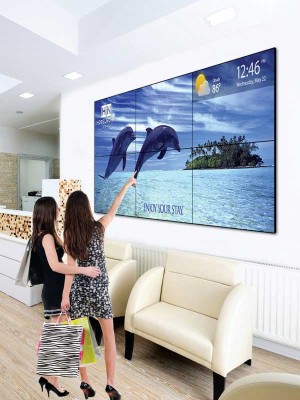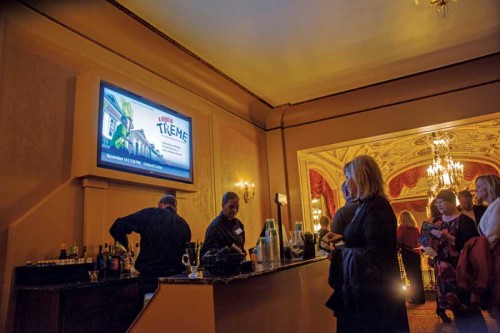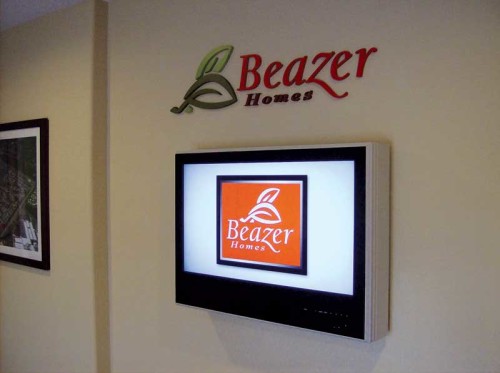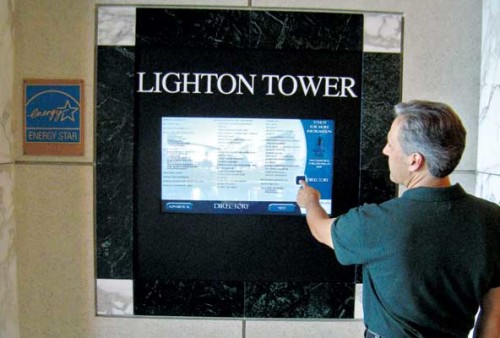Digital Signage: How to jump-start content
by all | 31 March 2016 2:13 pm

Photos courtesy Keywest Technologies
By David Little
Whenever communicating through the medium of digital signage, it is important to realize today’s viewers will not care about a message simply because it is digital in nature. The ‘cool’ factor of digital signage has long since worn off. There needs to be a better reason for them to be engaged.
Fortunately, digital signage has proven to be a strong platform for breaking out of old routines by experimenting with content. By having a bit of fun and jolting the audience with unexpected surprises, it can engage viewers well beyond a casual glance.
With the capability to change messages on the fly, based on scheduling, data or ‘environmental’ triggers, digital signage represents a new way to think about communications. Network managers are empowered to address the specific ways customers and employees think and behave in retail, transit and corporate facilities, to name a few. Digital signage is neither print nor TV and, as such, it requires a different approach.
Why content is important
With so much discussion of digital signage technologies, it is easy to overlook what the medium is all about in terms of getting actual results. Communications managers seek to add value to their businesses and, in the end, content is what delivers their strategy. And one of the most significant advantages of digital signage over other media is the ability to deliver on multiple strategies by changing content in opportune ways.
The ‘holy grail’ of digital signage has always been to deliver the right message at the right time to the right audience—i.e. relevance. Content can be designed to attract, engage and direct the attention of people at a point of decision, such as when they walk into a store.
The value of this goal has been well-established. According to a recent survey of quick-service restaurants (QSRs), for example, 30.8 per cent reported recouping their investment in digital menu boards (see page 40) within seven to 12 months, with an average five per cent sales lift for promoted food items and 20 per cent for beverages.

Fresh, dynamic content is important to catch people’s attention and engage them.
In a corporate setting, on the other hand, digital signage might be deployed in a lobby to welcome visitors as they arrive. In this context, the purpose is simply to build goodwill, but digital signage can also contribute to the ambience of interior décor.
In times of emergency, digital signage is particularly effective for sharing alerts sourced from third-party systems, such as the local police force. On-screen content can be co-ordinated with text alerts to provide up-to-the-second information to the public.
Similarly, in an industrial production plant, digital signage is well-suited for conveying safety information to large numbers of employees while they are actively working. Such communications can be vital in helping to maintain a safe and efficient facility.
Digital signage is in fact a significant opportunity for corporate communications, given 40 per cent of workers either do not have access to e-mail during the workday or do not read it in a timely fashion. Managers often rely on bulletin boards to get messages across, but the human brain is programmed to detect motion, so a more effective strategy is to place digital signs where employees take breaks, socialize and/or eat, using dynamic content to provide updates, reminders and any other messages of importance on any given day. Employee morale can also be improved by displaying contests, birthdays, other special events or the ‘employee of the month.’
Another purpose of corporate digital signage is to reduce the costs of training employees by scheduling and distributing educational videos across a network of screens. The medium has proven helpful in keeping staff informed of current corporate policies.
Making it stick
The term ‘sticky,’ as popularized on the Internet, refers to non-ad content that has the purpose of making users return to a site and will hold their attention for longer than just a glance. In digital signage, examples include news headlines, weather forecasts and contests.
Sticky content is important because ads—and some other types of digital signage content—are not engaging in themselves without the proper context. The idea is to piggyback one type of content onto another to yield greater overall value. People want to be informed and entertained, so digital signage should embrace the kind of mix that makes a media channel popular.
TV, by way of example, is good at informing and entertaining while also advertising. Simply recreating a TV channel on a public screen, however, will not automatically attract an audience. Rather, digital signage needs to cut through the ‘noise’ and deliver powerful messages that otherwise might be ignored.
Many of today’s professional media syndicators make it easy to incorporate sticky content through live streaming. Some even develop custom playlists with a mix of content that is specifically relevant to a given digital signage network’s audience.

In many cases, updated content can be imported from databases and other sources, as for this digital sign at a theatre’s bar area.
While syndicated content is highly desirable for the above reasons, however, it is important to beware of overusing it for fear of squandering the network’s core communications strategy. If too much sticky content is displayed, the core messaging can become diluted.
Instead, the mix should also incorporate fresh content focusing on the organization’s core communications efforts. The right balance of information sources will depend on the type of business, but once established, it will keep viewers coming back.
Content management tactics
It is important to establish upfront who will create content to drive the digital signage network. Given it can be expensive to outsource this task to a marketing agency, the following 10 tactics can help make the most out of existing resources.
1. Use templates.
Most of today’s digital signage systems offer built-in templates that can be used readily with only minor tweaks. These tools greatly reduce the time and complexity involved in creating and maintaining content. They can be repurposed to accommodate all types of information, from meals on a restaurant menu to scheduled events for a conference centre. And they can be used over and over again.
2. Tune into TV.
It may seem counterintuitive at first, especially in corporate environments, but supplementing digital signage content with TV programming is a proven method for attracting more attention. It also relieves much of the burden of constantly creating fresh content. Some digital signage systems offer optional TV tuners and are designed to incorporate TV shows within their screen layout. There are a few caveats to keep in mind, including (a) the requirement to pay commercial licensing fees to retransmit TV content and (b) the difficulty of competitive conflict, e.g. when a digital sign in a car dealership ends up displaying ads for its competitors.
3. Subscribe to syndication.
As mentioned, syndicated digital signage content services can be very useful. And rather than seek a broad range of news, network managers can choose feeds representing compatible areas of interest, so as to make the content more relevant in the eyes of the viewers.
4. Stream video.
Many of today’s digital signage systems also make it easy to integrate streaming video from a webcam. A retailer at a ski resort, for example, might stream scenic views from a mountaintop lodge. At an airport, passengers may appreciate control tower views of takeoffs and landings. The main benefit is fresh, dynamic content without having to devote personnel to creating it.

In a corporate setting, digital signage might be deployed in a lobby to welcome visitors or add to the ambience.
5. Import data.
Similarly, if content can be automatically imported from databases and other sources, staff is relieved from having to reformat or retype it for the screen. Tapping into data automation is an efficient way to repurpose existing resources without needing to hire a full-time content manager, graphics artist or other service provider. Widgets and other software can also be used to source news feeds, social media and corporate updates. It is simply a matter of starting out by identifying which data could populate which template fields.
6. Offer internships.
If a marketing manager can invest some quality time to mentor a student, digital signage content creation can be a great opportunity for a graphic arts student from a local community college, university or institute, whose programs are filled with participants looking for a chance to let their talents shine. This can be a real win-win scenario.
7. Choose the right software.
Digital signage software runs the gamut from easy-to-use to poorly designed user interfaces (UIs). Managers with little time to devote to digital content creation should carefully evaluate a content management system (CMS) before purchasing it, including the level of support offered by the developer.
8. Repurpose non-digital assets.
In addition to databases, most businesses also have access to existing analogue material—such as flyers, brochures, sell sheets and catalogues—that can be turned into digital signage content. Again, graphic arts interns or departments can be highly beneficial in reworking these resources to fulfil the specific requirements of the medium.
9. Repurpose other digital assets.
For that matter, a lot of existing digital content—such as corporate videos, presentations and branding—can be reused on screens if appropriate. The marketing department may be a rich source of valuable assets.
10. Use RSS feeds.
Really Simple Syndication (RSS) feeds from the Internet can be used to constantly update a screen with fresh content. In many cases, digital signage software is designed to support them as data sources. They can even be directed from the business’ own website, so as to reinforce corporate messaging, but there are also countless local and national feeds on various topics that could supplement the core communications strategy.

Touch screens engage passersby on a more personal level, even in a public space.
Engaging through interactivity
To be successful, marketers must present their messages in a context that enhances their value
to customers. A billboard, for example, might let highway drivers know about a restaurant or gas station at the next exit.
To this end, digital signage content must in some way capture the attention of viewers and then focus it on product features, information and/or entertainment that adds to the marketer’s branding efforts. For digital signage to be effective in a retail setting, for instance, the content needs to help make the shopping experience better than it would be without digital signage. One way to do so is to allow customers to interact with and/or change the content.
“The majority of truly successful and innovative media campaigns involve an element of spontaneity, whether it’s copy that can be adapted dynamically based on real-time data or an interactive component that allows the consumer to get involved,” said Sophie Burke, head of marketing for Zoom Media in the U.K., in an interview for a recent article by Geny Calosi for Output magazine.
“If you touch a screen, you are engaging on a more personal level, even if in a public space,” said Nick Mawditt, global director of insight and marketing for Kinetic, in the same article.
In the same way content on the Internet benefits by offering relevant interaction with users, so too can digital signage create a more helpful experience for viewers by adding interactivity. And with today’s mainstream availability and acceptance of touch screens, such consumer engagement does not necessarily need a huge budget.
Planning screen placement
Digital signage placement matters too, of course. No one will look up to a ceiling for announcements. Rather, product-specific content should be displayed at eye level close to the products in question. The closer the advertising is to the opportunity for a purchase, the more effective it will be.
By placing screens of optimal size in the best locations, the stage is set for creating content that stimulates viewers, influences their behaviour, reinforces branding and complements the surrounding environment.
Uniquely creative
While trial and error have helped many organizations become successful with digital signage, it is important to shake off the still-common notion that a ‘slide show’ is sufficient to engage viewers. The marketing strategy needs to be more creative.
With this in mind, full-service digital signage providers have a strong opportunity to help businesses design their campaigns. Through a discovery process, they can help determine what that organization’s ‘wow’ factor is, i.e. what is unique about it, and also research the audience to understand what it cares about. And once a successful call to action has been delivered on-screen, they can measure results with relation to return on investment (ROI) and return on objectives (ROO).
David Little is marketing consultant for Keywest Technology, which develops digital signage software and hardware. For more information, contact him via e-mail at davidl@keywesttechnology.com[1].
- davidl@keywesttechnology.com: mailto:davidl@keywesttechnology.com
Source URL: https://www.signmedia.ca/digital-signage-how-to-jump-start-content/